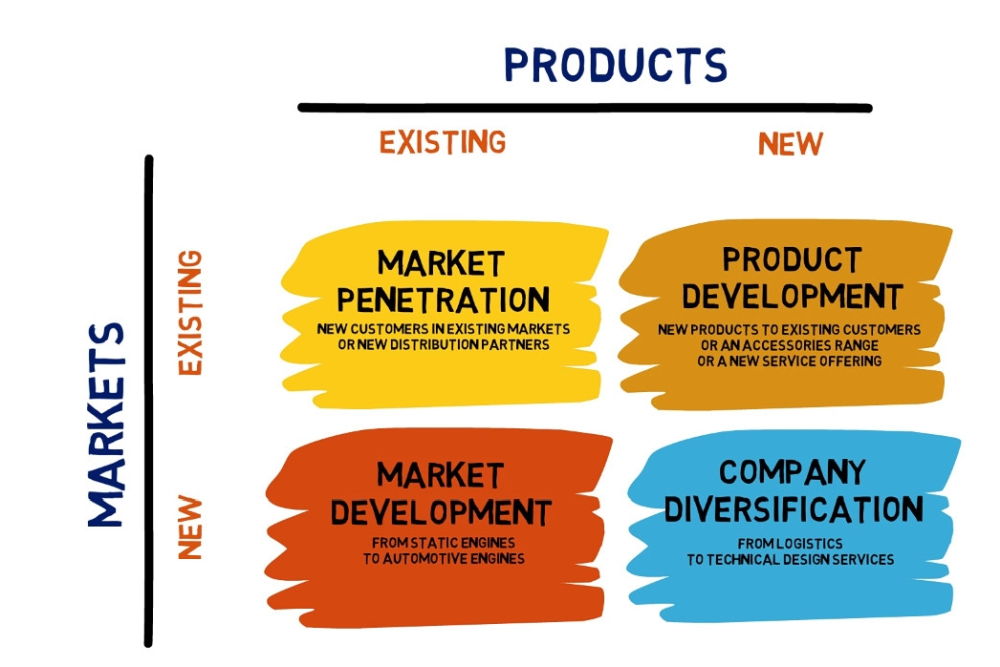4 steps for business growth
We’re writing this as the UK emerges from the COVID/Brexit recession although, in all honesty, when haven’t we been emerging from a recession? If there’s such a thing as an evergreen topic, “business growth” is it.
To put this recovery into focus, the Direct Marketing Association (DMA) has just released research that shows:
- 63% of UK businesses are starting to show signs of recovery.
- Only 16% of businesses now report the pandemic’s impact as being “extremely negative”; that figure stood at 31% in April 2020 and 25% in November.
- Overall, businesses now expect their revenue to decline by 24% as opposed to an expected decline of over 47% in May 2020.
- Businesses expect business growth of nearly 6% over the next 12 months. That would usually be cause for a huge celebration but, of course, we’re building from a very deflated start point.
Direct business growth with ye olde Ansoff Matrix
How will your business join this growth? If you’re not clear, now is the time to look at the Ansoff Matrix. It may have been created some time before the Big Bang but it helps you decide the general direction of your growth strategy. It helps you understand if you’re biting off more than you can chew.
Business growth from a new product or service
Long before you actually launch a new product or service, you need to go through this checklist:
- What markets exist?
- What’s the industry or profession?
- How many companies are in ‘your part’ of it?
- How many competitors already supply what you intend to supply?
- How many ‘units’ do customers buy of your product/service per annum?
- How much do they pay per ‘unit’?
- What could you carve out of the market?
- Why will customers buy your product/service?
- What goals or problems do your target customers face?
- How do your products/services address those goals or problems?
- How can you prove you can help customers?
- What makes your product/service different from the competition?
- Does your product/service concept need development to suit this market?
- How do customers buy your product/service?
- What’s your buyer’s usual job title?
- What do they care about?
- How is their performance measured?
- What purchasing processes do they follow?
- How do they select suppliers?
- Do they buy at a certain time of year or react to certain triggers?
- How do you reach your future customers?
- What do they pay attention to (trade associations, exhibitions, industry leaders, magazines, websites, YouTube channels, podcasts, LinkedIn groups, etc.)?
- How can you best put your message across (text, animation, video, web pages, social media, brochures, presentations, speaking engagements, handbooks, advertising, sponsorship, exhibition stands, podcast, seminar, webinar, etc.)?
- How will you train your sales team or distributors how to sell the product/service?
- What budget can you allocate to the project?
- What results do you expect and how will you measure them?
Most businesses think marketing exists in step 4 (b) and nowhere else. In truth, it doesn’t matter if you call the entire checklist marketing, sales planning or just business management. What matters is that it gets done. For more details, take a look at (Sales &) Marketing Strategy.
You want new markets
Imagining new markets isn’t difficult. If inspiration fails you, just look at where your competitors sell their products. If they have case studies from markets you don’t touch, investigate those markets.
You don’t have to do (much) product development when you’re selling an existing product to a new market. That doesn’t mean it’s easy. Here’s your new market checklist.
- Repeat the market research in step 1, above, for your new market.
- Check that your existing answers to steps 2 and 3, above, apply to your new market.
- Do companies in the new market have different goals and problems? If so, develop new reasons for them to buy your product/service.
- Do companies in the new market buy using different criteria or processes? If you were moving into public sector sales, for example, you’d need to develop tendering expertise.
- Repeat the planning in step 4, above, for your new market.
- Do companies in the new market pay attention to different people, channels and media? They almost certainly do so you need a new way to reach them.
Our page on Lead Generation will help you with more details on this process.
You want to improve your performance in current markets
It’s tempting to think you’re achieving all you can in an existing market. It’s rarely true. Even market leaders grow. Here’s your checklist for improving performance in existing markets:
- Do your campaigns reach your target audience? Check your email open rates. Check the reach of your social media campaigns. Do your advertising channels still have the reach you thought they did?
- Does your target audience pay attention to your campaigns? Check your email click-through rates. Check the reactions to your social media campaigns. Check reactions to your adverts.
- Does your target audience trust your brand? A brand attributes survey will tell you if your campaigns are a waste of time and effort. If your brand doesn’t command attention, fix that first.
- Is the product/service right for the target market? Has a new competitor emerged? Does your target market expect new capabilities from its suppliers? If so, people might remember your brilliant campaign but they won’t buy your product/service.
- Are you pitching the product/service at the right price? Price doesn’t just mean the price tag. Is free delivery expected? Have 3-year warranties become standard? Do your competitors offer money-back guarantees?
- Are you selling it the right way? A huge amount of business switched from physical to online sales during COVID. After Brexit, many businesses found it easier to sell to Europe through distributors instead of direct.
- Contact customers and prospects to gauge their reaction to your campaign. Is there a problem with the creative, the channel, the media or the budget?
If you want to understand your brand better, our guide on brand marketing will give you the answers you need.
Your next steps
There are two ways to put this growth review into action:
- Most businesses can follow all 14 steps without outside assistance. Even if you’ve not done it before, you can learn all you need to know from our Little Black Books on (Sales &) Marketing Strategy, Lead Generation, Market Research and Brand Marketing. You don’t need a PhD. But you do need time.
- If you don’t have the time that’s when you call us. By using an outside consultancy, the project is completed accurately, efficiently and on time. It doesn’t get hijacked by day-to-day activities.
Remember, Forbes Baxter Associates is a marketing development agency so we develop your in-house marketing skills while we help you grow your business.


